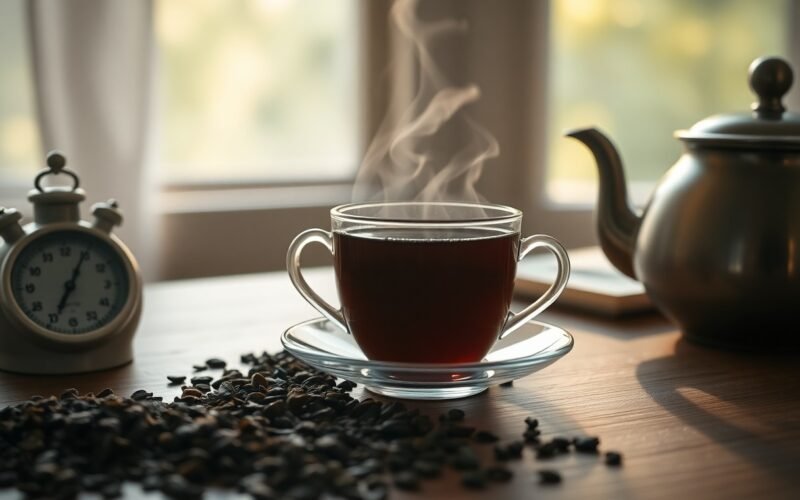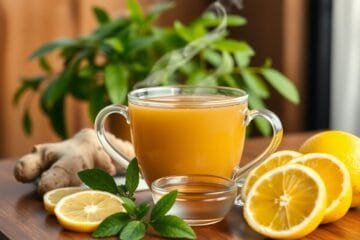Most tea enthusiasts agree that brewing the perfect cup of tea is an art that balances temperature, steeping time, and tea quality. By mastering these elements, you can elevate your tea experience from ordinary to extraordinary. In this guide, you will learn the imperative steps to ensure each cup is a delightful journey of flavors, customized to your taste. Whether you prefer black, green, or herbal tea, you’ll discover how small adjustments can make a big difference in flavor and aroma.
Key Takeaways:
- Select high-quality tea leaves or bags for the best flavor profile.
- Pay attention to water temperature and steeping time, as they can greatly affect the taste.
- Use the right tea-to-water ratio for your preferred strength, usually one teaspoon of loose tea per cup of water.
Selecting the Right Tea
Your choice of tea significantly impacts the overall experience of your brew. Consider exploring a variety of loose leaf and bagged teas to discover flavors that resonate with your palate. Many tea aficionados recommend selecting high-quality selections from reputable brands, which you can learn more about in our guide on How to Brew the Perfect Cup of Tea. Trust your senses, and let your preferences guide you toward the perfect blend.
Understanding the Flavor Profiles of Different Teas
Teas come in a myriad of flavors, each with its own distinct characteristics. For instance, black teas tend to offer robust, bold flavors, while green teas provide a lighter, more grassy profile. Herbal teas can range from sweet to savory, depending on their components. Aiming to understand these profiles not only enhances your selection process but enriches your brewing experience, allowing you to pair them with your mood, meals, or time of day.
Quality Indicators to Look For in Loose Leaf vs. Tea Bags
The quality of your tea plays an necessary role in achieving the desired flavor and aroma. In loose leaf tea, look for whole leaves rather than broken ones, which often indicates freshness and superior taste. In contrast, bagged teas can vary; higher-quality brands may use larger tea leaves in their bags, while lower-quality ones often rely on powdered tea leaves known as “dust.” Always check packaging details and opt for brands that prioritize quality to elevate your tea experience.
When evaluating tea quality, take note of several indicators that can significantly affect flavor. For loose leaf teas, the size and presence of whole leaves are telltale signs of freshness—larger, unbroken leaves typically yield more complex flavors. For tea bags, opt for those that feature natural fibers like silk or paper instead of plastic, which can affect the taste. Additionally, avoid sachets filled with dust-like particles; these are usually signs of lower quality. Researching brands and reading reviews will also help you make informed choices and enjoy a consistently delightful brew.
Mastering Water Temperature and Brewing Time
Achieving the perfect cup of tea requires meticulous attention to water temperature and brewing time. The right temperature enhances the extraction of flavors and aromas, while the ideal brewing duration ensures that your tea isn’t overly bitter or weak. Refer to the table below to guide your brewing process for a variety of tea types.
| Tea Type | Optimal Temperature & Time |
|---|---|
| Green Tea | 160-180°F (70-80°C), 2-3 minutes |
| Black Tea | 190-212°F (88-100°C), 3-5 minutes |
| Oolong Tea | 190-205°F (88-96°C), 4-7 minutes |
| White Tea | 160-185°F (70-85°C), 4-5 minutes |
| Herbal Tea | 200-212°F (93-100°C), 5-7 minutes |
The Science of Temperature and Its Impact on Flavor Release
Flavors in your tea are intricately linked to temperature; higher temperatures facilitate faster extraction of flavors and compounds. For example, black tea thrives at near-boiling temperatures, effectively releasing robust flavors and tannins. Conversely, green tea benefits from lower temperatures to avoid bitterness while accentuating its delicate taste. The table below illustrates their relationship.
| Temperature Range (°F) | Effect on Flavor |
|---|---|
| 160-180 | Sweet, light flavors |
| 180-190 | Balanced extraction |
| 190-200 | Full-bodied taste |
| 200-212 | Robust and strong |
| Over 212 | Bitterness and harshness |
Brewing Times for Various Types of Tea
Each tea variety possesses optimal brewing durations, crucial for unlocking its full flavor potential. Green tea generally requires a shorter infusion of 2-3 minutes to avoid bitterness, whereas black tea can steep longer, between 3-5 minutes, to develop its character. Oolong tea falls in the middle, benefiting from 4-7 minutes to capture its complex flavors. Refer to the table for precise timings applicable to different teas.
| Tea Type | Brewing Time |
|---|---|
| Green Tea | 2-3 minutes |
| Black Tea | 3-5 minutes |
| Oolong Tea | 4-7 minutes |
| White Tea | 4-5 minutes |
| Herbal Tea | 5-7 minutes |
- Green tea brews in 2-3 minutes.
- Black tea needs 3-5 minutes to steep properly.
- Oolong tea benefits from 4-7 minutes.
- White tea can steep for 4-5 minutes.
- Herbal tea usually requires 5-7 minutes.
Any tea enthusiast will find that experimenting with these specific water temperatures and brewing times can lead to discoveries about personal taste preferences. Adjusting your methods based on these guidelines will enhance your tea experience significantly.
The Importance of Proper Equipment
Having the right equipment can significantly enhance the flavor and quality of your tea. Using appropriate tools not only ensures that the tea is brewed correctly but also helps you achieve consistency with every cup. Invest in quality items like a kettle that accurately heats water to the desired temperature and a reliable timer for precise brewing times. For guidance on equipment and techniques, check out How to make a proper brew.
Essential Tools for the Home Brewer
Every tea lover should have a few crucial tools on hand. A good quality kettle is a must, preferably one with temperature control features. A teapot or infuser that allows for proper steeping is also crucial. Additionally, consider having a digital thermometer and a timer to keep everything precise. These tools work together to help you create the perfect cup every time.
How Different Brewing Methods Affect Taste
The way you brew tea can dramatically influence its flavor, aroma, and even its health benefits. Various methods such as steeping, infusion, or using a French press yield different results. For example, using loose leaf tea in an infuser generally allows the leaves to expand, releasing more flavor compared to a tea bag which restricts the leaves. Furthermore, the type of vessel used can impact the heat retention during brewing, which also affects flavor extraction.
In general, brewing methods like cold brewing tend to produce a smoother, less astringent cup, while traditional steeping can yield a more robust flavor. The water’s contact time with the leaves plays a pivotal role; extending steeping time might intensify bitterness, while a shorter time can yield a gentler bouquet. Experimenting with these methods can unveil a spectrum of taste profiles, allowing you to find what suits your palate best.
Elevating Your Tea with Additives
Enhancing your tea experience can be as simple as adding a few carefully selected ingredients. The right additives can transform a great cup into something extraordinary. Whether you prefer creamy, sweet, or spicy notes, experimenting with different enhancements allows you to tailor each brew to your taste preferences, creating a personal signature blend that elevates your tea moments.
Common Enhancements: Milk, Sugar, and Spices
Adding milk, sugar, or spices can greatly enhance your tea’s complexity. Milk lends a rich and creamy texture, balancing the tannins found in strong black teas. Meanwhile, sugar sweetens and highlights the inherent flavors, while spices like cinnamon, ginger, or star anise infuse warmth and dimension. These traditional enhancements are beloved in various cultures and can easily be adjusted to suit your palate.
Creative Flavor Combinations for a Unique Brew
Taking your tea game to the next level often involves exploring innovative flavor combinations. Think of pairing chamomile with vanilla and honey for a soothing floral experience, or try a robust chai blend infused with the warmth of cardamom and cloves. Creating unique blends can awaken your senses and inspire new favorite brews, giving you the chance to enjoy tea like never before.
For a truly distinctive cup, let your creativity flow by using seasonal ingredients or flavors that personally resonate with you. For example, consider pairing green tea with fresh mint and a splash of citrus for a refreshing summer drink or mixing hibiscus with pomegranate juice for a vibrant fall concoction. You can also infuse your tea with aromatic herbs like basil or thyme, which can add unexpected yet delightful twists to traditional flavors. The possibilities are endless; let experimentation guide you in creating a perfect cup that reflects your unique taste.
Troubleshooting Common Brewing Issues
Brewed tea can sometimes fall short of your expectations, but various strategies can help you refine your technique. Common issues like bitterness or weakness may stem from an imbalance in steeping time or tea quantity. Adjusting your approach can enhance flavor and elevate your overall tea experience, ensuring you always enjoy that perfect cup. Don’t be discouraged; even seasoned tea drinkers face hurdles—let’s look into the most frequent problems and how you can solve them.
Bitter vs. Weak Tea: Finding the Right Balance
The battle between bitter and weak tea often hinges on steeping time and tea quantity. Oversteeping can lead to extraction of tannins, creating a bitter taste, while too short of a brew may leave you with a bland cup lacking depth. Aim for the sweet spot by following recommended brewing times based on the specific tea type, and always measure your loose leaf or tea bags to achieve consistency. Adjustments may be necessary, but with practice, you’ll hit that ideal balance.
How to Rescue a Botched Brew
A botched brew can be disheartening, but there are ways to save your cup. If your tea is too bitter, consider diluting it with a splash of hot water to mellow the taste. For a weak brew, increase the strength by steeping an additional tea bag or adding a pinch of loose leaves to boost flavor without brewing a whole new cup. Each of these small adjustments can turn a disappointing tea experience into a better one.
Sometimes, you can also explore creative avenues to salvage your tea. If it’s overly bitter, sweetening it with honey or sugar can create a pleasant contrast. Adding a squeeze of lemon can incorporate acidity and vibrancy, which masks unwanted bitterness. For weak tea, blending it with a stronger type or incorporating milk can enhance the flavor profile and richness. Experiment with various additives to discover your favorite methods for rescuing your brew.
Final Words
Conclusively, brewing the perfect cup of tea each time is entirely within your grasp by diligently following the steps outlined above. Always pay attention to water quality, temperature, and steeping times for your specific tea type. By mastering these elements, you can enhance your tea experience profoundly. For further detailed insights, you may explore r/tea – Instructions to make the perfect cup of tea according …. Enjoy your future tea brews!
FAQ
Q: What type of tea is best for beginners, and how should it be brewed?
A: For beginners, black tea or green tea are excellent choices. Black tea typically has a robust flavor, making it easier to enjoy even without added ingredients. To brew black tea, use water that has reached a rolling boil (around 212°F or 100°C) and steep the tea for 3-5 minutes. For green tea, use slightly cooler water (around 175°F or 80°C) and steep for 2-3 minutes to avoid bitterness. Always follow the recommended steeping time on the tea packaging for the best results.
Q: How can the water quality affect the taste of my tea?
A: The quality of water used in brewing tea directly impacts its flavor. Hard water, which contains higher levels of minerals, can alter the taste and aroma of the tea, often resulting in a flat or off balance flavor profile. Ideally, use filtered or spring water, which is free from impurities, to ensure a clean and pleasant taste. Additionally, avoid using distilled water, as it may lack the important minerals that enhance the flavor of tea.
Q: Why is proper storage of tea important, and how should I store it?
A: Proper storage of tea is vital for maintaining its freshness and flavor. Tea leaves are sensitive to light, moisture, and odors, which can degrade their quality over time. To store tea effectively, keep it in an airtight container made of opaque material and store it in a cool, dark place. Avoid proximity to strong-smelling substances, such as spices or coffee, to prevent the tea from absorbing unwanted flavors.




